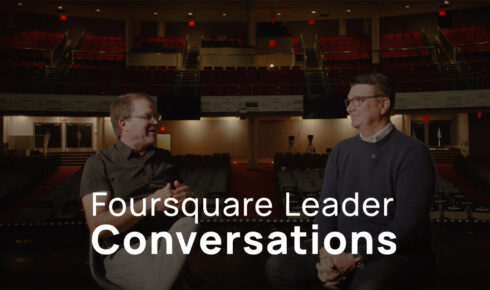All of us are familiar with the quintessential picture of Jesus as He welcomed children to Him, opening His arms in ministry: ” ‘Let the little children come to Me, and do not forbid them; for of such is the kingdom of God’ ” (Luke 18:16, NKJV).
Jesus’ model was to assign real significance to children—to take them on His lap. In doing so, He laid out the responsibility not just for parents, but also for the whole church to engage in the lives of children.
During Foursquare Connection 2011, the denomination’s annual international convention that was held in Columbus, Ohio, General Supervisor Tammy Dunahoo noted this sobering trend: The number of next-generation, or NextGen, pastors is declining across the Foursquare movement.
But this trend is merely a mirror of current American society. According to a recent Barna report, “twentysomethings continue to be the most spiritually independent and resistant age group in America.” Research reveals that as many as 61 percent of twentysomethings who attended church in their younger years have become disengaged.
Foursquare President Glenn Burris Jr. challenged the 2,500 convention delegates in Ohio to consider “what if”—What if our churches became places filled with multicultural and multigenerational groups of people who represent a “tapestry of generations”?
Goals + Visions
In order to achieve a goal like this, it’s becoming more imperative than ever that churches embrace ministry to the NextGen population, beginning at the earliest age. The challenge is for Foursquare churches to develop a holistic approach to ministry that reaches the entire NextGen populace—a group defined by Foursquare as “cradle through college.”
Some churches are thinking outside the traditional box and finding creative ways to harmonize the generations. A.J. Swoboda, senior pastor of Theophilus Church (Hawthorne Foursquare Church) in Portland, Ore., invites children in his church under age 13 to engage in ministry by serving communion to the adults once a month.
Lesli Klingenmeier, NextGen representative for the Mid-Atlantic District, believes that engaging relationship with kids really begins by nurturing a relationship with the parents.
“It’s essential,” Lesli asserts, “that we engage the family before they even start their families.”
Her vision of an effective church model that reaches every generation is one that partners with families through every transition in life. It’s important to start with fostering a vision for a continuous plan for children’s ministry—one that begins with a partnership between parents and the church before a child is even born and extends all the way through the child’s transition into college.
The Problem
The obvious problem stares all of us in the face every day: Kids are growing up faster, becoming more sophisticated earlier, and finding information about the world at their fingertips.
Tweens—youth that fall between ages 8 and 12—are a growing segment of today’s population, representing over 20 million Americans, according to the most recent census. This age group is expected to hit almost 23 million by 2020.
Gregg Johnson, a Foursquare credentialed minister and founder of J12 (Jesus at 12) Ministries, reiterates the need to reach kids younger—before they reach age 12.
“These are the hinge years of life,” Gregg tells Foursquare.org, “and the decisions they make at the age of 12 become the launch pad for how they live their whole lives.”
Industry research reveals that children, even as young as 11, don’t consider themselves children anymore, and adolescents are now being singled out as independent, mature consumers. An average tween is exposed to between 3,000 and 5,000 marketing messages every week, and collectively tween consumers spend over 50 billion dollars per year. They represent the single-largest target market for the music industry and for MTV.
In addition, 80 percent of tweens report feeling stressed and pressured by peers and parents. By age 12 or 13, their worldview is already being shaped.
Good News
Herein lies some good news. As David Kinnaman, president the Barna Group, noted in an October 2007 report titled What Teenagers Look for in a Church, young people who attend church don’t simply want more information—they want “to worship or make a connection with God.” In fact, 45 percent of teens surveyed described this as very important.
Young people want to know God, but they don’t want to listen to religious teaching or merely participate in a discussion about faith. They desire to experience God in a tangible way.
In addition to wanting a connection to God, youth long for connection to people, and they are choosing role models among those with whom they are closest. As a 2009 article published by USA Today reported, 85 percent of tweens surveyed agreed that their families were the biggest influence in their lives, and 70 percent considered their moms and dads to be their best friends.
Oftentimes, however, the reality for the church is that the parents of many children, tweens and teens are not connected to the church. Finding ways to team up and connect with families who need help is challenging.
Hard Questions
Heidi Strickler, assisting minister at Harbourtown Community (Vermilion Foursquare Church) in Vermilion, Ohio, makes an important observation.
“Sometimes we are afraid to ask ourselves the hard questions,” Heidi says. “The church is afraid to admit that we are failing in some areas. Looking honestly at ourselves can be painful, but this is a critical time to be honest.”
Chris White, NextGen pastor at Fountainhead (Carson City Foursquare Church) in Carson City, Nev., practices what he calls a “family model” in his youth group.
He and his team recognize the importance of creating a family atmosphere of safety and trust, building a foundation that some kids in his community don’t find at home. Once a week, his team picks up kids from school and drives them to church, where they do homework together and share a meal before their youth group activities.
The statistics may seem to paint a bleak outlook. But there is a lot of light at the end of the tunnel.
“The maturation years are ripe with spiritual possibilities,” Kinnaman writes. “Helping [young people] connect with God, learn about their faith, and serve others, in a loving and relational environment,” is one important aspect to turning the statistics around.
This is good news for those of us in the church who want to reach and raise up young people. While there are no easy formulas for reaching a younger and more sophisticated generation, Foursquare churches across the country are finding many successful and creative avenues of ministry to engage young people for the long haul.
In Parts 2 and 3 of this article series, we will look at some exciting ways that Foursquare churches and leaders are reshaping NextGen ministry and leading the way for a new paradigm of ministry to young people who are vitally engaged in their faith.
You are reading Part 1 of a three-part series.
Read Part 2: “New Paradigms for NextGen Ministry”
Read Part 3: “Creating an Alternative to Culture”
Get Resources » We’ve compiled a helpful list of NextGen resources, as recommended by fellow Foursquare leaders across the nation.
By: Amy Swanson, a pastor’s wife and director of women’s ministry at New Life Church in Santa Barbara, Calif.


